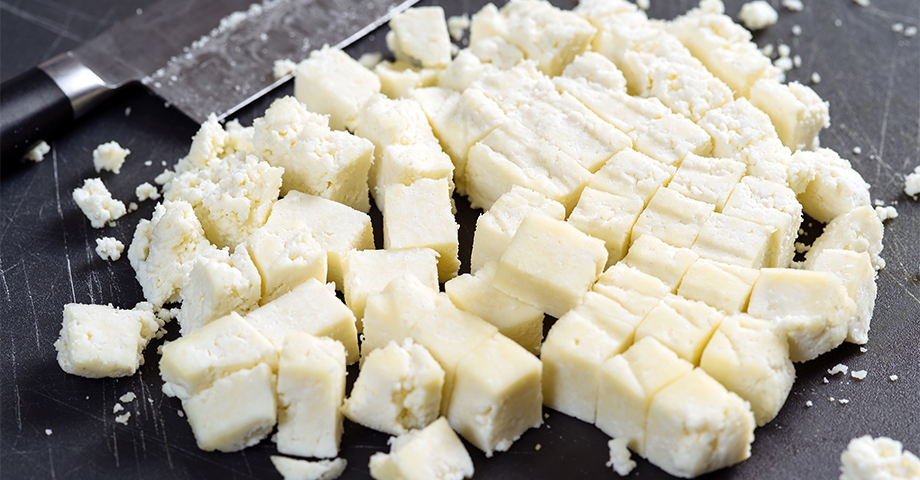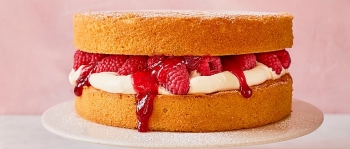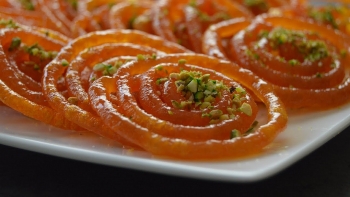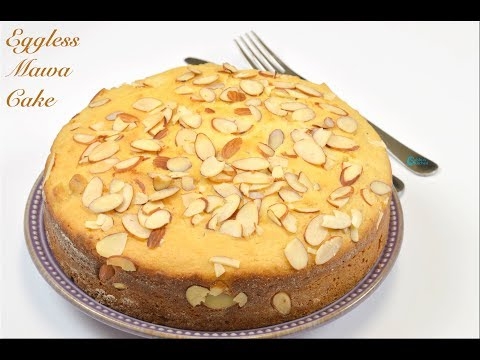How to make paneer at home with a simple recipe
WHAT IS PANEER?
 |
| Photo: Cultures for Health |
Paneer cheese is a classic Asian cheese, common in India. It’s unaged and made by curdling milk with acid then pressed. And, perhaps one of it’s most loved features – paneer is a non-melting cheese.
Without melting, paneer has become a staple in a large variety of dishes. This includes saag paneer (a spinach and cheese appetizer dish), which is how I first ate it and fell for the malleable, soft juicy cheese texture and flavor.
How To Make Paneer Cheese
Makes about 10 ounces or 2 cups of cheese cubes
INGREDIENTS
- 1/2 gallon
whole milk, not UHT pasteurized
- 1/4 cup
lemon juice or vinegar
- 1/4 to 1/2 teaspoon
salt
EQUIPMENT
-
4-quart saucepan
-
Slotted spoon
-
Strainer or colander
-
Mixing bowl
-
Cheesecloth, nut bag, or other cloths for straining
-
Dinner plates
-
Weights, like a 32-ounce can of tomatoes
INSTRUCTIONS
-
Heat the milk: Pour the milk into the saucepan and set over medium heat. Bring the milk to a bare simmer — just below the boil at around 200°F. Stir the milk occasionally, scraping the bottom of the pot to make sure the milk doesn't scald. When ready, the milk will look foamy and steamy.
-
Add the lemon juice: Remove the milk from heat and stir in the lemon juice. The milk should begin to curdle immediately, but it's ok if it doesn't.
-
Let the milk stand for 10 minutes: Cover the milk and let stand for 10 minutes to give the acid time to completely separate the curds and whey. At the end of 10 minutes, the curds should be completely separated and the liquid should look yellow and watery. If the milk hasn't separated, try adding another tablespoon of acid. If it still won't separate, check your milk and be sure you are using non-UHT milk; this kind of milk won't separate.
-
Strain the curds: Set a strainer or colander over a mixing bowl and line it with cheesecloth, a nut bag, or other straining cloth. Carefully scoop or pour the curds into the strainer, letting the whey collect in the bowl beneath.
-
Squeeze the curds: Gather the cheesecloth in your hand and gently squeeze to remove the excess whey.
-
Salt the curds: Open the cheesecloth and sprinkle 1/4 teaspoon of salt over the curds. Stir gently and taste. Add more salt if desired.
-
Press the curds: Transfer the curds (still in the cheesecloth) to a large dinner plate. Shape them into a rough square and then fold the cheesecloth tightly around the curds to form a neat rectangular package. Set a second plate on top of the package and weigh it down. Press for at least 15 minutes or up to 1 hour.
-
Use or refrigerate the paneer: Once pressed, your paneer is finished and ready to use. You can use it immediately or refrigerate for up to two days. Refrigerated paneer will be firmer and less likely to crumble than fresh paneer.
| RECIPE NOTES Whole vs. 2% vs. Non-Fat Milk: While whole milk is our favorite for making ricotta, 2% milk can also be used, though the ricotta is slightly less rich and creamy. Avoid using skim and nonfat milks; these don't separate as easily into curds and whey. Pasteurized Milk: Pasteurized milk is fine to use for making ricotta, but avoid UHT (Ultra High Temperature) pasteurized milk as this process changes the protein structure of the milk, preventing it from separating. Using the Leftover Whey: The leftover whey can be used in place of water in any baking recipe, whizzed into smoothies, or drunk on its own over ice, according to thekitchn. |
 How to make a simple cake at home - Top cake decorating trends for 2021 How to make a simple cake at home - Top cake decorating trends for 2021 |
 How to make Jalebi at home? How to make Jalebi at home? |
 Super Easy Tutorial to make Cool Knotless Braids - top Braid trends for 2021 Super Easy Tutorial to make Cool Knotless Braids - top Braid trends for 2021 |


























